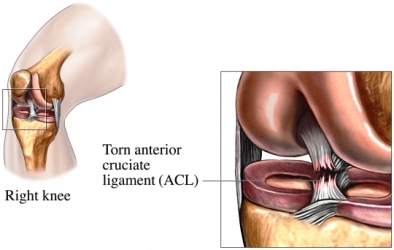Historically, Anterior Cruciate Ligament (ACL) tears are a painful injury that few people recover from completely. It is common for professional sportsmen and women to retire soon after ACL tears as they have failed to recover to the necessary level to return to their sport; however, as medicine progresses with this type of injury, this is no longer the case. While the injury is painful and the recovery road is often long, it is an injury that you can recover from and manage afterwards.
 The purpose of the ACL is to stabilize the knee while it is in a resting position. ACL damage is therefore one that causes problems and discomfort even when the person is not moving. While a tear to the ACL is damaging on its own, the real danger is in a hugely increased risk of further injury to other parts of the knee.
The purpose of the ACL is to stabilize the knee while it is in a resting position. ACL damage is therefore one that causes problems and discomfort even when the person is not moving. While a tear to the ACL is damaging on its own, the real danger is in a hugely increased risk of further injury to other parts of the knee.
Treatment comes in many stages, but medical professionals changed the treatment schedule to now include pre-treatment, which effectively prepares patients for the surgical aspect of treatment.
Pre-treatment involves stretching the muscles and ligaments to strengthen them ready for undergoing surgery. Activities such as slow cycling on a stationary bike or use of a cross-trainer are examples of exercises that can be used to prepare a patient for the usual treatment. Exercises that strengthen the quadriceps and hamstrings are key to this aspect of rehab. The intensity of these exercises for ACL tears should be carefully monitored by a physical therapist or sports injury professional.
Whether the tear is major or not, it usually requires surgery in order to recover from the damage incurred with the tear. ACL damage cannot recover on its own as it lacks a direct blood supply of its own. The surgical work to the ACL is done by reconstruction rather than repair and is typically done over a few weeks and number of surgeries as the inflammation must settle down between.
The surgery is particularly invasive, and a number of artificial fixations are used to hold the reconstructed ligament in place. After surgery, it is common to have severe discomfort during the rehabilitation that follows. Rehabilitation after surgery is arguably more important than the surgery itself.
Physical therapy is key to the rehab of ACL tears, and exercise is essential for recovery. Exercise must be done under the correct conditions to avoid further damage. After surgery, the knee is very weak and it must be kept stable to allow recovery.
Physical therapists usually break rehab into multiple stages that range from simply managing the pain to beginning an exercise regime to regaining something close to a full range of motion. A variety of exercises can be used to stretch and recondition the muscle. Similar to before cycling or cross-trainer work is very popular but a variety of static and compound exercises will be used in conjunction with physical activity. Check with your physical therapist to discuss what rehab regimen will be right for your particular recovery.
